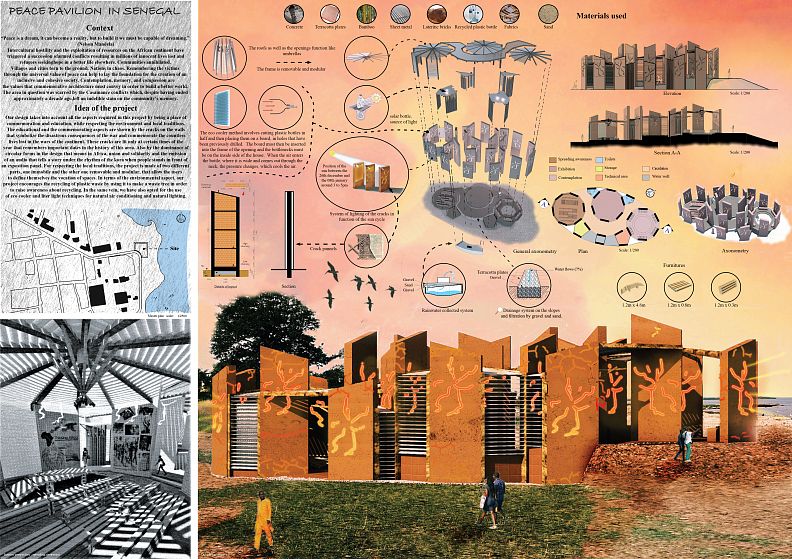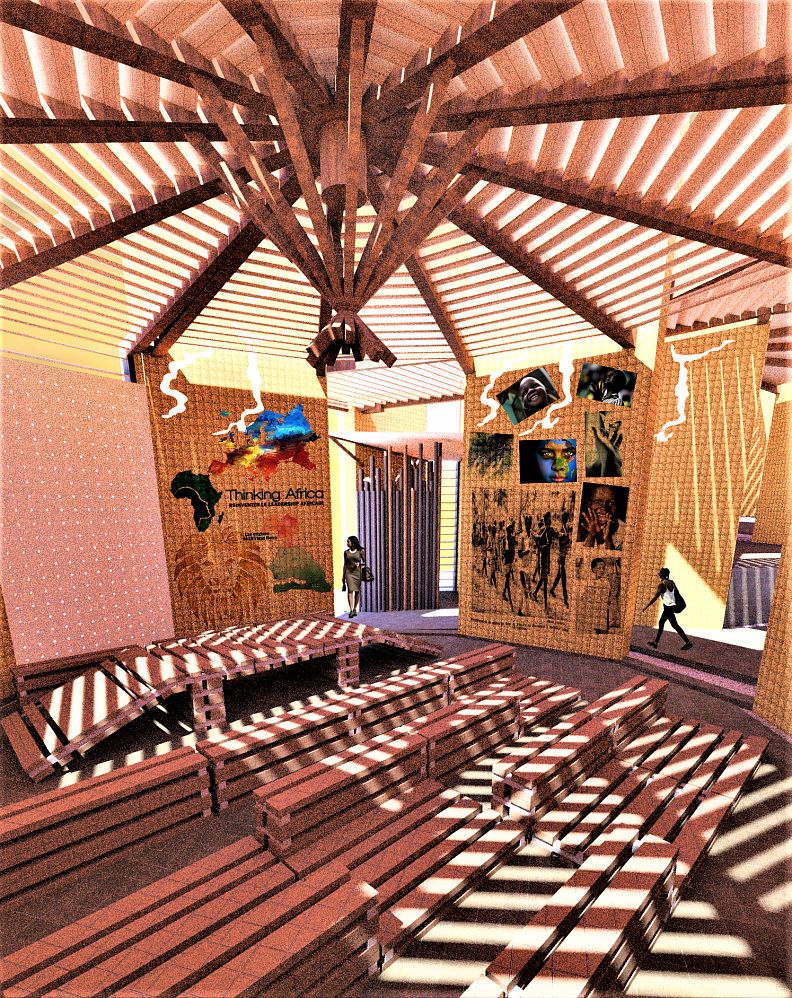PEACE PAVILLION

Idea projektu
The objective of this project is to design a symbolic architecture for the memory of the
victims of African wars, which can sensitize the local and international community by
creating a place of commemoration and education, while respecting the environment and local
traditions.
In our project, we can notice the dominance of the circular forms that signify in Africa, union
and solidarity. Our project is made of two different parts, one immobile and in this case, the
walls that symbolize the sustainability of our project and the other one removable and
modular, in this case the openings and the cover that allow the users to define themselves the
vocation of spaces.
Popis projektu
Cracks on the walls symbolize the disastrous consequences of the war and commemorate the
countless lives lost in the wars of the continent. These cracks are lit only at certain times of
the year, from December 26th, which corresponds to the beginning of the war in 1982 in
Casamance to January 8th, which corresponds to the date of the first peace talks in 1996.
The roofs as well as the openings function like umbrellas and are removable which allows to
open them partially as completely and to close them at will so you can enjoy the natural
lighting at will and protect from the weather when needed.
The building tells the story by its characteristics. On the courses are arranged in some places
just in front of the exhibition panels of the pallets below which there is a mechanism that
reacts to the weight by emitting an audio that tells a story under the rhythm of the kora which
is a musical instrument found in the region.
In terms of the environmental aspect, our project encourages the recycling of plastic waste by
using it to make a waste tree in order to raise awareness about recycling. In the same vein, we
have also opted for the use of eco cooler and liter light techniques for natural air conditioning
and natural lighting.
The eco cooler system not only reduces the temperature in the premises but also recycles nonbio degradable plastic bottles. This method involves cutting plastic bottles in half and then
placing them on a board, in holes that have been previously drilled. The board must then be
inserted into the frame of the opening and the bottlenecks must be on the inside side of the
house. When the air enters the bottle, where it is wide and comes out through the neck, the
pressure changes, which cools the air. It does not need electricity to operate and can
immediately lower the temperature by 5 degrees.
The system of liter of light is used in the same way to recycle and manufacture solar lamps
that allow illuminating our premises and cracks in the walls. This system is to fill the plastic
bottles of water and water jaw, which eliminates the algae and avoids that the water turns
green. And then the bottles are installed in the roofs of houses to refract the 360 degree light
and offer a natural bulb during the day and during the night, we will use lanterns for the
lighting.
The water supply on the site will be at the lake during the construction phase and during the
use phase due to a rainwater recovery system. Rainwater is collected in a fountain trough a
drainage system on the slopes and filtration by gravel and sand. The water used is recovered
directly from the fountain by a manual water collection system with buckets. To save water,
we will use manual flush toilets. A manual flush toilet is similar to a flush toilet with the
difference that the water is poured by the user and does not come from a tank above. As with
traditional flush toilet, a siphon prevents odors and insects coming back from the pipe. To
reduce water requirements, toilet paper will be collected separately.
Waste management on the site will be done by bins made of recycled plastic waste and will be
compartmentalized according to the different types of waste namely, biodegradable,
recyclable, inert and dangerous.
Technické informace
This project has two different parts, one immobile and in this case, the walls and the
foundations. The walls are in lateritic bricks that are local materials and can be found easily in
the area. They were used in order to protect the inside of the premises of the noise nuisance.
For good acoustic insulation, the materials with a high density must be used because it is more
difficult to make them vibrate and they transmit noise less well. The foundations are at
different levels in each local. Therefore, the awareness local is 45cm from the ground, the
exhibition space is at 1m45 and the highest space is that of the contemplation which is at
2m45 of the ground. The soles and columns are made of reinforced concrete, the basement
walls are made of solid brick of cement and the floor is in terracotta plates.
The second part of this project consists of removable elements, in this case, the openings and
the coverage that are also made of local materials, namely wood, bamboo, metal sheets and
fabrics.
CONSTRUCTION PROCESS
Earthwork
Spoil cleared of all organic debris, supplemented if necessary by the sand, will be able to serve as embankments. These embankments will be executed in successive layers of 0.15 m thick, carefully watered and compacted.
A drain will be made following the slope for the flow of rainwater.
The insoles are insulated and are dosed at 350kg / m3
Chained down: Of 0,30m of thickness and 0,40m of height, it will be executed on the concrete of foundation. The dosage will be 350 kg / m3.
Chaining high: From 10 cm X 30 cm, they will be executed on the walls in elevation. The dosage will be 350 kg / m3.
Columns: columns at each end of the wall will be provided from elevation to low chaining.
The dosage indicated is 350 kg / m3.
The walls in elevation: They will be in lateritic bricks cut 0.30 m thick. Of dimensions 20 cm x 30 cm x 15 cm. The blocks to be used will be taken and roughly cut in a quarry located in the locality.
Covers and openings: they will be made of wood, bamboo and sheets.











